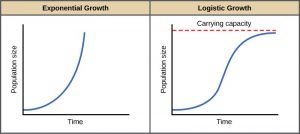
Vancouver Island as seen from North Shore Mountain. The phytoplankton used in the experiment were sampled from Vancouver Island. (Source: Morgan Strohan)
As the environment changes with time and climate, the ability for a species to survive is dependent on the resources available to support body functions. The process by which nutrients from the environment are converted into the energy needed to support an organism is called metabolism. As temperatures increase, the metabolic rate of species increases; this means that resources in the environment are used up faster to produce energy. While previous studies looked at the effects of temperature on a species’ population growth rate, Dr. Joey Bernhardt and her colleagues decided to look at how temperature affects a species’ population carrying capacity, and how the metabolic theory of ecology (MTE) can explain these effects.
Background of the experiment
Phytoplankton were sampled in areas around Vancouver Island, from the Pacific Ocean.
Several populations of phytoplankton were kept under a fixed supply of resources between 5-38°C for forty-three days. As the phytoplankton’s ideal temperature is 25°C, the researchers measured their oxygen production between 8-24°C so as to see the rates of photosynthesis and respiration (their metabolic functions). It was found that carrying capacity declined with increasing temperature.

Phytoplankton is a simple organism relative to multicellular organisms so it provides a good model within the lab. (Source: Dr. Joey Bernhardt)
The stability of the environment
Carrying capacity describes the maximum size of a species population in a certain environment as a function of time, which is related to the amount of resources available. As resources are limited, the environment can only support a certain number of organisms. Carrying capacity is reached over time as resources are used up and the population growth rate naturally reaches zero.

[The phytoplankton] grow from almost no cells, through an exponential phase, and then eventually they plateau out; upon plateauing, they’ve reached carrying capacity. (Source: Wikimedia Commons)
Listen to the podcast below to hear why!
Why does this all matter?
Given all this information on theories and phytoplankton, what does this really mean as a big picture and why is it important? We know that along with climate change comes warming waters in our oceans. As stated above, warming temperatures have obvious effects on populations, specifically phytoplankton in this case. But just because phytoplankton may seem boring and meaningless to most people doesn’t mean these results don’t have a much bigger meaning to all other species on Earth!
Watch the video below to find out just what phytoplankton have in common with every other species on this planet, and what warming temperatures could really mean…
https://www.youtube.com/watch?v=EaiHPaPpkLE&fbclid=IwAR1XoKBAzlKoEtgSdTzPUTrywKhkuXNJEmZ_6SUlN1l9Ymk-YvO-3uhgPd4
As we can see, the factors of temperature, metabolism and the surrounding environment all have significant effects on a population. Climate change is currently happening and we are already starting to see the effects on ecosystems around the world, both in oceans and on land. We are not able to predict all outcomes – as there are many unknowns associated with climate change – but Dr. Joey Bernhardt said it best: “One thing we can say for sure is that warming temperatures will undoubtedly accelerate metabolic rate, and this will have predictable effects on abundance.”
By Gabi Rosu, Morgan Strohan, Dan Choi, and Olivia Wong
